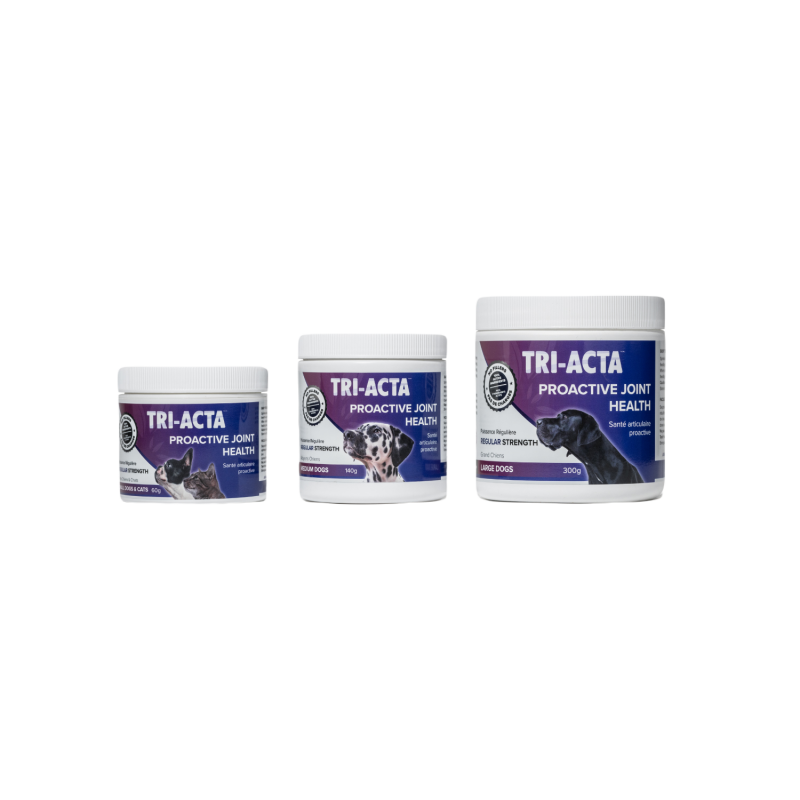Table of Contents
If you eat a healthy diet, you’ll need fewer trips to the doctor. The same can be said for our pets. If you feed your dog or cat a healthy, balanced diet, they’ll have more energy, have a healthier, shinier coat, and have fewer digestive issues (barring any allergies). After all, you are what you eat!
But feeding your pet a healthy diet is just one piece of the preventative pet health puzzle. While we can’t 100% control whether our pets get sick or not (just like us), we can take other important measures to keep our furry friends happy and healthy for as long as possible.
In this article, we explore preventative pet health, including why it is important, steps you can take to be prepared if your doggo or kitty does get sick, and specific preventative health recommendations for dogs and cats.
Why is Preventative Pet Health Important?
Imagine that you get a brand new Golden Retriever puppy. This happy little guy quickly wins your heart with his quirky behaviour and fun-loving personality. He will be a great buddy and make a positive difference in your life for years.
But did you know that breeds like Golden Retrievers have a high risk of hip dysplasia? The condition is a painful one, resulting in your pup’s hip joints not forming correctly, eventually leading to the hips dislocating partially or fully (depending on the severity of the condition).
According to data from the Orthopedic Foundation for Animals (OFA), as many as 20% of Golden Retrievers have abnormal hips. This is because the dog is a purebred, and the gene responsible for the condition hasn’t yet been identified. The organization has collected data on hip dysplasia for different breeds since 1994 and is ongoing.
Knowing this information, you might not be able to completely prevent your Golden from developing the condition as they age, but you’re likely to want to do anything to protect your puppy from suffering from the pain and discomfort of the condition as they grow.
Thankfully, there are some preventative measures that you can take to help your hypothetical Golden Retriever puppy that is likely to develop hip dysplasia:
- Feed them a daily joint supplement, such as TRI-ACTA H.A. This powdered supplement can be easily added to your dog’s daily diet, whether you feed them wet, dry, or raw food. With two types of glucosamine (for overall joint support), chondroitin (for cartilage support) and Methylsulfonylmethane (MSM, which helps prevent inflammation), and hyaluronic acid (improves the viscosity of the synovial fluid in your pup’s joints, allowing for easier movement) this supplement contains everything your puppy needs for lasting joint support. Giving hyaluronic acid has been scientifically proven to be an effective preventative tool for dogs with elbow dysplasia, so there’s no reason it couldn’t help for hip dysplasia.
- Avoiding playtime and exercise that puts extra strain on their joints, such as games that have your dog jump repeatedly or require them to turn on a dime. Instead, consider activities like swimming (the water’s buoyancy reduces weight on joints), tug-o-war, or long walks.
- Regular checkups at your vet to keep track of your dog’s growth to ensure that their hips are growing correctly. If your vet notices anything unusual, they can recommend further action, such as surgery or even a dog hip brace.
With preventative care, a dog with hip dysplasia can live a full, healthy, and happy life. But without preventative treatment, getting a dog with hip dysplasia to a point where they are pain-free and able to move properly is much more difficult. In some cases, the condition can become so severe that humanely euthanizing the dog is the best option.
As you can see from the example, knowing the risks surrounding your pet's health and taking preventative measures is essential to ensure that your pet has the best life you can give them. In some cases, preventative pet health can be as simple as giving your pet a daily supplement and adjusting their lifestyle.
TRI-ACTA for Pets
A proactive approach for developing and younger adult pets to maintain optimal joint health mobility, minimize inflammation and fend off age-related ailments.

Why You Should Spay and Neuter Your Pets
A significant pet preventative health measure that all pet owners should observe is spaying or neutering their pets. The ASPCA states that approximately 6.3 million animals enter shelters annually in the United States. 3.1 million of those animals are dogs, and 3.2 million are cats. In addition, 920,000 shelter animals (390,000 dogs and 530,000 cats) are euthanized yearly. In Canada, the numbers are a bit lower but still significant. Data from Humane Canada shows that 20,974 dogs were admitted to shelters in 2021, with 10% euthanized. On the other hand, 60,677 cats were admitted to shelters in the same year, with 11% ending up euthanized.
The stats are shocking, but the reality is that not spaying or neutering your pets contributes to these numbers. It’s no secret that irresponsible or accidental breeding contributes significantly to local animal shelter populations. By spaying or neutering your pet, you’re contributing to reducing those numbers by being part of the solution rather than the problem.
In addition to the benefits of population control, here are several general health and behavioural benefits of spaying and neutering pets, as outlined in the table below:
|
Behavioural Benefit of Spaying/Neutering |
Health Benefits of Spaying/Neutering |
|
|
More specific benefits with regard to behaviour and health for dogs and cats will be covered in later sections of this article.
General Pet Preventative Health Plan Recommendations
Sometimes you can’t completely prevent health issues from occurring in your pet. Like hip dysplasia in some dogs, some health issues are inevitable. You can still take preventative pet health measures to improve your pet’s life and potential outcome of an illness, but if you don’t have access to your pet’s complete genetic and medical history (which is often the case with rescue animals), it can be difficult to predict whether they are likely to get sick or not. Nobody can predict the future, even if your dog or cat has the cleanest and strongest genetics.
Getting a pet preventative health plan—or pet insurance—is essential. Most pet owners can’t afford to drop hundreds or thousands of dollars on an unexpected trip to the vet. Pet insurance helps alleviate some of that burden by covering some or all of a surgery, procedure, medication, or general vet visit.
In general, you’ll want to look at a pet preventative health plan that covers pet wellness, such as:
- Annual or bi-annual vet visits
- Unexpected vet visits
- Medications and supplements
- Physical and behavioural exams
- Regular tests such as heartworm, fecal, FIV (for cats), etc.
- Nail trim
- Microchip
- Spay or neuter
- Flea control
- Deworming
To standardize veterinary care for dogs and cats, the American Animal Hospital Association (AAHA) and the American Veterinary Medical Association (AVMA) compiled medical information from a variety of professional organizations, including the American Heartworm Society, American Association of Feline Practitioners, and Companion Animal Parasite Council to develop the Feline Preventative Healthcare Guidelines (FPHG) and Canine Preventative Healthcare Guidelines (CPHG).
It might sound like a mouthful, but these guidelines were developed to help your furry friend live their best possible life! To make things easy to understand, we break down the content of these guidelines in the next two sections, plus highlight some more specific health benefits of spaying or neutering your pet.
Dog Preventative Health Care Guidelines
When it comes to keeping your pup happy and healthy, the first considerations that the CPHG outlines for dog preventative health are:
- Lifestyle and life stage
- Behaviour
- Diet
These three things are essential to keep in mind because, at a high level, they are the best indicators of your dog’s overall health. Let’s say you have a dog at the puppy life stage. Puppies usually are very active, so if you have a puppy that just wants to laze around all day, that could be a red flag regarding their health.
Behaviour is also important. You know your dog best; if they are usually a happy-go-lucky pup that loves people but suddenly start growling and baring teeth at anyone new that they come across, that indicates that something could be wrong healthwise.
Diet is also an important contributing factor to your dog’s overall health. If your dog’s daily diet is more comparable to fast food than a healthy, home-cooked meal, then that will affect every aspect of their health from behaviour to energy levels and digestion.
In addition to keeping your dog’s lifestyle, life stage, behaviour, and diet in mind, getting at least one annual veterinary examination is important. However, many dogs require more. The frequency of visits should be determined by yourself and your veterinarian.
During a veterinary visit, your vet will conduct a comprehensive physical examination that looks at several important indicators of your dog’s health:
1. Dental Assessment
Looking at your dog’s teeth can give your veterinarian key information regarding your dog’s overall health. Like humans, teeth can harbour bacteria, which can build up in your dog’s mouth in the form of plaque and tartar. This buildup of bacteria can result in pain, infections, tooth loss, and inflammation of the gums. Poor canine oral hygiene can also lead to more problems than just what occurs in the mouth; it can also affect kidney, liver, and heart health. Regular dental exams are important so that early signs of gum inflammation and plaque and tartar buildup can be treated through removal before they become a serious problem for your pup.
2. Pain Assessment
Pain is an extremely important indicator of your dog’s overall health. Detecting that your pup is feeling any sort of pain, even mild, can begin an early treatment plan to eliminate the pain or ensure that it doesn’t increase further. Dogs will instinctually try to hide their pain. In the wild, a weak or sickly dog is a liability for the entire pack, as the sick dog will attract predators because it's an easy target. As a result, a pack of dogs will leave behind a dog demonstrating signs of being sick or weak. Sometimes, you won’t be able to tell that your dog is suffering any pain until they get a physical exam by a vet. Just like humans, getting “ahead” of the pain with dogs is important, as it’s easier to get your pup to a point where they are comfortable with mild pain compared to severe pain.
Given that up to 20% of dogs over one year old are likely to develop a degenerative joint disease (DJD) or arthritis, conditions that can result in constant pain, one of the most important preventive measures you can take is giving your pup a daily joint supplement.
TRI-ACTA is a great preventative supplement for dogs that don’t have joint problems or their joint problems are mild. What makes TRI-ACTA different is that the supplement contains 100% natural and active ingredients, so you’re not paying for fillers or additives that provide no benefit for your dog, and it contains two types of glucosamine: sulfate and HCl. Glucosamine sulfate provides sulfur to your pup’s joints, which is essential to maintain healthy joint structures and tissues. Glucosamine HCl is highly bioavailable, so your dog’s body can get the benefits of glucosamine (lubrication, improved cartilage repair and regeneration, better joint mobility, etc.) faster.
Suppose your pup already has a joint condition and needs more support. In that case, TRI-ACTA H.A. is our extra-strength version that contains hyaluronic acid, increasing the viscosity of the synovial fluid, and lubricating your pup’s joints.
3. Body and Muscle Condition Scoring
Another important exam that your vet will perform is body condition scoring (BCS). This system has been developed to help determine whether a dog or cat is at a healthy weight and has a normal amount of muscle simply by looking at the animal and feeling their body in different areas. A body condition assessment can also be performed at home, but getting a professional’s opinion is always a good idea.
Suppose your veterinarian finds your dog’s body condition is lower than it should be. In that case, proactive steps can be taken to determine the potential cause, including blood tests and other exams.
TRI-ACTA H.A. for Pets
Our maximum strength formula is optimally designed to accelerate the formation of cartilage, minimize inflammation, expedite the healing process, and improve joint conditions.

General Tests and Other Considerations
Some specific common diseases and ailments affect dogs that should be regularly inoculated against or tested for. These include:
- Canine distemper virus—a highly contagious disease (to other animals) that attacks the respiratory, gastrointestinal, and nervous systems of dogs and puppies
- Canine parvovirus—a highly contagious (to other dogs) and often fatal disease that results in lethargy, loss of appetite, abdominal pain and bloating, fever or low body temperature, vomiting, and severe, bloody diarrhea
- Canine adenovirus-2—also known as kennel cough, this disease is highly contagious (to other dogs) and primarily affects the respiratory system
In addition to getting your dog vaccinated for common but serious illnesses, you should also microchip them in case they get lost. A canine microchip is a small (about the size of a grain of rice) piece of technology inserted under the skin, usually just between the shoulder blades. If your pup is ever lost and found by someone, they can bring them to any vet or animal shelter to be scanned, providing the facility with your information so somebody can contact you.
Specific Behavourial and Health Benefits of Spaying and Neutering Dogs
We discussed the importance of spaying or neutering your pets in a previous section. This section highlights more specific behaviour and health benefits of spaying or neutering your dog is important:
|
Health Benefits to Spaying or Neutering Dogs |
Behavioural Benefits to Spaying or Neutering Dogs |
|
|
Cat Preventative Health Care Guidelines
Like the canine guidelines, the FPHG also states that the three most important considerations for keeping your cat healthy and happy are lifestyle and life stage, behaviour, and diet. For the most part, the signs and symptoms that you should watch out for with regard to cat preventive health are the same as dogs, but with some differences.
1. Dental Assessment
Like dogs, veterinarians can learn about your feline’s health by looking at their teeth. Poor dental hygiene can result in similar ailments to dogs, including inflamed gums, periodontitis (tissue and bone damage), and risks to the kidneys, liver, and heart. Tooth resorption is a common issue with cats, where the inside of a tooth erodes and, therefore, requires extraction. Approximately 20–60% of cats will experience tooth erosion.
Usually, cats need to be sedated with local anesthetic for dental exams. This is important because cats can stress easily. Most cats have little tolerance for anyone manipulating their mouth, and it can be tough for any vet to clean your cat’s mouth without it.
2. Pain Assessment
Cats don’t like to show their pain for the same reasons as dogs: if a cat in a colony is perceived to be weak and sickly by the others, they will shun it for fear of the cat attracting predators. But given that cats are generally aloof already, detecting when your kitty is experiencing pain can be even tougher.
Thankfully, the feline grimace scale was developed to help veterinarians and cat owners see when their kitty might be in pain. Paying attention to your cat’s distinct facial and ear movements and positioning can determine the difference between a cat that’s annoyed at the current situation or in pain. If your vet and you suspect that your cat is in some sort of pain, measures can be taken to prevent the pain from becoming worse or to eliminate the pain.
Just like dogs, cats can experience joint pain. It’s estimated that feline arthritis and mobility problems can affect up to 40% of cats of any age. One of the best preventative measures to help prevent your kitty from developing serious joint problems is giving them a daily joint supplement like TRI-ACTA. Like with dogs, if your kitty already has arthritis or joint issues, then consider our extra-strength supplement with hyaluronic acid, TRI-ACTA H.A.
3. Body and Muscle Condition Scoring
Felines have their own muscle and body condition scoring system that can be used to assess their general health. While this test can be performed at home, getting a professional’s opinion on your cat’s body condition is recommended. Since cats often weigh much less than dogs, even a small increase or decrease in weight can significantly impact their body condition score.
General Tests and Other Considerations
You should get your kitty vaccinated against specific feline-specific diseases and viruses. These include:
- Feline panleukopenia virus—a highly contagious (between cats) and often fatal disease that results in depression, anorexia, high fever, vomiting, diarrhea, and severe dehydration
- Feline herpesvirus-1—a common eye and upper respiratory infection that is unique to cats, and is also highly contagious to other cats only
- Calicivirus—an upper respiratory and oral disease that often occurs in cats that causes sneezing, nasal congestion, pink eye, and discharge from the nose and eyelids
- Feline leukemia virus (FELV)—a type of cancer that causes anemia (low red blood cell count) and suppression of the immune system, which opens up the infected cat to suffer various other diseases and viruses
- Feline immunodeficiency virus (FIV)—has clinical signs similar to FELV, but is typically a less aggressive form that’s often spread from an infected male cat biting another male cat
Just like with dogs, cats should also be microchipped. In fact, considering that many cat owners let their cats outside, microchipping your cat is even more important. The microchip in cats is also inserted just under the skin, between the shoulder blades.
Specific Behavourial and Health Benefits of Spaying and Neutering Cats
Spaying or neutering your cat has many preventative pet health benefits that help them live longer, healthier, and happier lives. These benefits are outlined in the table below:
|
Health Benefits to Spaying or Neutering Cats |
Behavioural Benefits to Spaying or Neutering Cats |
|
|
Summary
Our pets are important members of our family. Ensuring that they stay healthy and happy as they age is paramount. One of the most important ways that you can ensure that your dog or cat remains healthy is by observing preventative health measures, like taking your pet for regular vet visits, feeding them a healthy diet, and giving them supplements like TRI-ACTA to support their joint health.
Purchase TRI-ACTA online today or learn where to buy at a store near you.
TRI-ACTA H.A. for Pets
Our maximum strength formula is optimally designed to accelerate the formation of cartilage, minimize inflammation, expedite the healing process, and improve joint conditions.

Newsletter Signup
Subscribe to our newsletter to receive the latest news and exclusive offers.
.jpg?height=2000&name=Cliick_Integricare-DISPLAY-REVISEDV2%20(1).jpg)
Proactive & Therapeutic Joint Supplements
When given daily, Integricare joint supplements recover bone and joint injuries faster and help prevent mobility injuries from happening in the first place.











